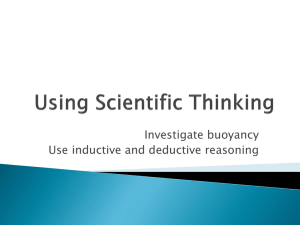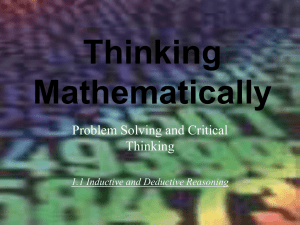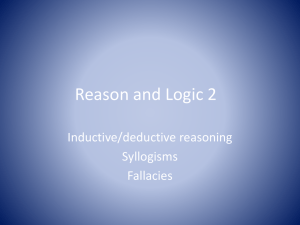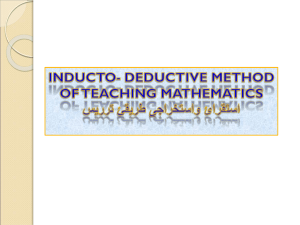DeductivevsInductiveReasoning
advertisement
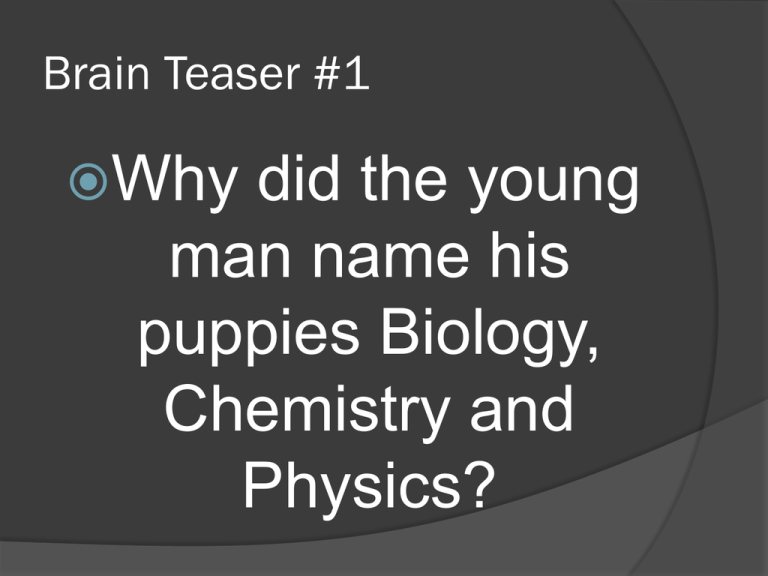
Brain Teaser #1 Why did the young man name his puppies Biology, Chemistry and Physics? Brain Teaser #2 What has a face without eyes, and hands without arms? Reasoning!? What’s that??? Reasoning is the act of drawing a conclusion. You use premises to help you draw a conclusion. Some conclusions are more reliable than others. It’s important to know if a conclusion was made using deductive reasoning or inductive reasoning. One is based on KNOWN FACTS that can be proven. The other is based on OBSERVATIONS that don’t always mean what you think they do! Why is important to know which one was used?? How do we start?? Reasoning starts by examining a premise, or a statement. After examining the premise, a conclusion is made. Deductive Reasoning Deductive reasoning is the process of reasoning from known facts to conclusions. The known facts are trusted, or sound, premises. When you reason deductively, you can say “therefore” with certainty. If your facts are true to begin with, then your conclusions will also be true. Deductive Reasoning Example Known Fact: The brochure for soccer camp says cut-off date for camp registration is June 6. All kids registering after that date will go on a wait list, no exceptions. Known Fact: It is three days past the cut-off date, and you have not registered your child. Conclusion: Your child will not be registered and will go on the wait list. Is the conclusion definitely true? Partner A, tell partner B what you think the answer is and why. YES! The argument starts with KNOWN FACTS! The conclusion is based on FACTS! If the cut off date is June 6 for registration, and you are trying to register after June 6, then you go on a waiting list! No exceptions! The conclusion can be made with certainty. It is firm! Will more evidence make your argument stronger? If you saw a website or got a phone call that also said the deadline was June 6, would this make your conclusion more convincing? Partner B, tell Partner A what you think the answer is and why. NO! In deductive reasoning, once a solid statement is made, you do not need more statements to improve your conclusion. Brain Teaser #3 What did one half say to the other half as they were walking down the road together? Deductive Reasoning Does the argument start with a known fact or an observation? Is the conclusion definitely true? Can you add more evidence to make it more convincing? Inductive Reasoning Inductive reasoning is the process of going from observations to conclusions. The premise is something you have observed. This type of conclusion is sometimes called an inference. Successful inductive reasoning depends on the quality of your observations, or evidence. Inductive Reasoning Example Observation: Susan is seen walking from her car to her home with a brand new tennis racket. Observation: Susan’s son, David, loves tennis, and today is his birthday. Conclusion (inference): Susan has bought the tennis racket for David. Is the conclusion definitely true? Partner B, tell Partner A what you think the answer is and why. NO! Susan could have borrowed a tennis racket from someone. Susan could have bought herself a tennis racket. The conclusion could be described as probable, but not firm. Will more evidence make your argument stronger? If you found a receipt for a tennis racket in Susan’s car and a birthday card with a picture of a tennis player on the front, would this make your conclusion more convincing? Partner A, tell partner B what you think the answer is and why. YES! In inductive reasoning, more evidence makes your argument more convincing. Brain Teaser #4 What is it that leaves but goes nowhere? Inductive Reasoning Does the argument start with a known fact or an observation? Is the conclusion definitely true? Can you add more evidence to make it more convincing? Let’s take a moment to review… What have we learned so far today? Reasoning is used to draw conclusions. There are two types, deductive and inductive. Deductive reasoning begins with known facts, the conclusion is firm, and additional evidence does not help make the conclusion more convincing. Inductive reasoning begins with observations, the conclusion could be different than what we think, and more evidence would help make the conclusion more convincing. Model – Deductive or Inductive The National Heart Institute researchers state that if you fry food, you will add more fat than if you had baked the food. The choices in the cafeteria today are fried chicken and baked chicken. The fried chicken has more fat in it than the baked chicken. Model Known fact: The National Heart Institute researchers state that if you fry food, you will add more fat than if you had baked the food. Known fact: The choices in the cafeteria today are fried chicken and baked chicken. Conclusion: The fried chicken has more fat in it than the baked chicken. More evidence? Don’t need it! The researchers are trusted experts. It’s a FACT, fried food has more fat than baked food! A different conclusion? No! There’s no way you can be wrong if the known fact is correct! Is this deductive or inductive reasoning? Questions to ask yourself: Does the argument start with a known fact or an observation? Can you add more evidence to make it more convincing? Is there any other conclusion you could make? Whole Group – Deductive or Inductive? Your teacher was sneezing and blowing her nose a lot today. You did not see your teacher after lunchtime today, and you noticed a substitute teacher in her classroom. Your teacher left early to go to the doctor. Whole Group – Deductive or Inductive? Observation: Your teacher was sneezing and blowing her nose a lot today. Observation: You did not see your teacher after lunchtime today. Conclusion: She left early and went to the doctor. More evidence? This would help confirm, or verify, our conclusion! If we overheard her telling a coworker that she was going to the doctor, our conclusion would be more convincing! A different conclusion? Of course! Our teacher could be going to a meeting. That doesn’t mean she isn’t sick, but we can’t say FOR SURE that she is going to the doctor. Partner – Deductive or Inductive? You will be responsible for deciding whether or not an example uses deductive or inductive reasoning. You must explain your decision to your partner. How will you decide which type of reasoning was used to draw the conclusion? Partner – Deductive or Inductive? Partner A – Your best friend looked upset in the hallway today. Lots of students were holding Social Studies tests in their hands. Your friend got a low score on the test. Partner B – Students who receive more than 2 tickets are not allowed to go to incentive. John has received 4 tickets this grading period. He will not be at the incentive. Partner B! Tell us what Partner A decided! Your best friend looked upset in the hallway today. Lots of students were holding Social Studies tests in their hands. Your friend got a low score on the test. Known facts or observations? Observations Is the conclusion definitely true? NO! Would more evidence make the conclusion more convincing? YES! What type of reasoning is this? INDUCTIVE! Partner A! Tell us what Partner B decided! Students who receive more than 2 tickets are not allowed to go to incentive. John has received 4 tickets this grading period. He will not be at the incentive. Known facts or observations? Known facts! Is the conclusion definitely true? YES! Would more evidence make the conclusion more convincing? NO! What type of reasoning is this? DEDUCTIVE! Its bottom is hidden, its head hard to find. Its mouth always open as it speaks to mankind. Leaves no footprints, nary a track, travels the world around and back. No light of its own, a guide for men; mover of waters Within a sailors ken. A great transformer but having no form; useful at times, at others, a storm. I exist at war’s outset, in the midst of battle, and at the end of all conflict Assessment You will now test out your new skills by completing an assessment. This assessment will let us know how well you can use your new skills. Please do your best! Don’t forget to use your test taking skills. On the back of your paper, please complete the So what? Who cares? What now? activity on the next slide. So What? Who cares? What now? So what!? What was our objective today? What is deductive reasoning? What is inductive reasoning? Compare and contrast the two forms of reasoning. Use a Venn diagram. Who cares!? How will learning this help you? What now!? What would happen to your deductive reasoning if the premise that you started with was FALSE?!?
